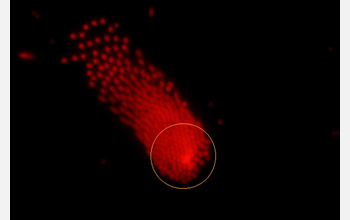Multimedia Gallery
Rapid Electrokinetic Patterning (Image 2)
An individual nanoparticle, part of a pattern in a new technique called rapid electrokinetic patterning. [Image 2 of 3 related images. See Image 3.]
More about this Image
This image was taken from a video illustrating a new technique developed by researchers at Purdue University that uses a laser and holograms to precisely position clusters of numerous tiny particles within seconds, representing a potential new tool for analyzing biological samples or creating devices using "nanoassembly." The red dots are individual particles.
The technique, called rapid electrokinetic patterning, is a potential alternative to existing technologies because the patterns can be more quickly and easily changed. Manipulating and assembling micro- and nanoparticles is important for a variety of micro-engineering applications including developing lab-on-a-chip technologies and creating crystalline particle architectures. [This research was supported by a National Science Foundation grant.] (Date of Image: August 2008)
Credit: Stuart J. Williams, Aloke Kumar and Steve Wereley, Birck Nanotechnology Center, Purdue University
Images and other media in the National Science Foundation Multimedia Gallery are available for use in print and electronic material by NSF employees, members of the media, university staff, teachers and the general public. All media in the gallery are intended for personal, educational and nonprofit/non-commercial use only.
Images credited to the National Science Foundation, a federal agency, are in the public domain. The images were created by employees of the United States Government as part of their official duties or prepared by contractors as "works for hire" for NSF. You may freely use NSF-credited images and, at your discretion, credit NSF with a "Courtesy: National Science Foundation" notation.
Additional information about general usage can be found in Conditions.
Also Available:
Download the high-resolution JPG version of the image. (68 KB)
Use your mouse to right-click (Mac users may need to Ctrl-click) the link above and choose the option that will save the file or target to your computer.



